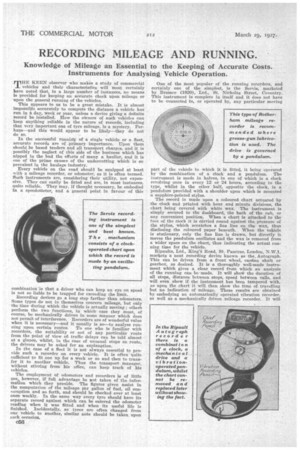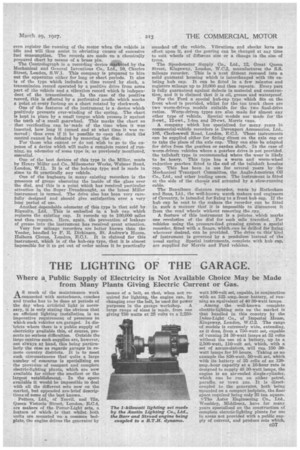RECORDING MILEAGE AND RUNNING.
Page 126

Page 127

If you've noticed an error in this article please click here to report it so we can fix it.
Knowledge of Mileage an Essential to the Keeping of Accurate Costs. Instruments for Analysing Vehicle Operation.
THE KEEN observer who makes a study of commercial vehicles and their characteristics will most certainly have noted that, in a large number of instances, no means is provided for keeping an accurate check upon mileage or upon the general running of the vehicles.
This appears to us to be a great mistake. It is almost impossible accurately to compute the distance a vehicle has run in a day, week or year, unless a device giving a definite record be installed. How the oivners of such vehicles can keep anything reliable in the nature of records, including that very important one of tyre mileage, is a mystery. Perhaps—and this would appear to be likely—they do not do so.
In the successful runnidg of a single vehicle or a fleet, accurate records are of primary importance. Upon them should be based tenders and all transport charges, and it is possibly the neglect of this side of the business which has nipped in the bud the efforts of many a haulier, and it is one of the prime causes of the undercutting which is so prevalent in the haulage industry.
Every vehicle on the road should be equipped at least with a mileage recorder, or odometer, as it is often termed. Such instruments are, considering their utility, not expensive. They can easily be fitted and are, in most instances, quite reliable. They may, if thought necessary, be embodied in a speed onleter, and a general point in favour of this
combination-is that a driver who can keep an eye on speed is not so liable to be trapped for exceeding the limit.
Recording devices go a long step farther than odometers. Some types do not in themselves concern mileage, but only the time during which the vehicle is actually moving ; other perform the two functions, in which case they must, of course, be mechanically driven in some manner which does not permit of interference. Recorders are of wonderful value when it is necessary—and it usually is so—to analyse running upon certain routes. To one who is familiar with recorders, the suitability or not of any particular route from the point of view ofi traffic delays can be told almost at a glance, whilst, in the case of unusual stops en route, the drivers may be asked for an explanation. In the case of a fleet it is not always essential to provide such a recorder on every vehicle. It is often quite sufficient to fit one up for a week or so and then to transfer it to another vehicle. Thus the transport manager, without stirring from his office, can keep track of his vehicles.
The employment of odometers and recorders is of little use however, if full advantage be not taken of the infer,/nation which they provide. The figures given assist in the computation of the mileage par gallon of fuel, oil consumption and so forth, and should be checked over at least once weekly. In the same way every tyre should have its separate record against which can be entered the odometer reading when it was fitted and when its useful life is finished. Incidentally, as tyres are often changed from one vehicle to another, similar note should be taken upon each occasion.
One of the most popular of the running recorders, and certainly one of the simplest, is the Servis, marketed by Bramco (1920), Ltd., St. Nicholas Street, Coventry. This instrument is complete in itself and it does not have to be connected to, or operated by, any particular moving part of the vehicle to which it s fitted, it being operated by the combination of a clock and a pendulum. The instrument is made in halves, in one of which is a clock revolving once in every 12 or 24 hours, according t6 the type, whilst in the other half, opposite the clock, is a pendulum provided with a shoulder upon which is mounted a sapphire-pointed stylus.
The record is made upon a coloured chart actuated by the clock and printed with hour and minute divisions, the chart being covered with white wax. The instrument is simply secured to the dashboard, the back of the cab, or any convenient position. When a chart is attached to the face of the clock it is carried round against the pressure of the stylus, which scratches a fine line on thn wax, thus disclosing the coloured paper beneath. When the vehicle is stationary, only the fine line is drawn, but directly it moves the pendulum oscillates and the wax is removed from a wider space on the chart, th.us indicating the actual running time for the vehicle.
Ripaults, Ltd., King' A Road, St. Pancras, London, N.W.1, markets a neat recording device known as the, Autograph. This can be driven from a front wheel, cardau shaft or gearbox, as desired. It is a thoroughly well-made instrument which gives a clear record from which an analysis of the running can be-made. It will shoW the duration of all stops, distance between stops, speed between calls, and will even show if the instrument has been tampered with, as upon the chart it will then show the time of travelling but no indication of mileage. These results are obtained by embodying an automatically operated vibration recorder, as well as a mechanically driven mileage recorder. It will
even register the running of the motor when the vehicle is idle and will thus assist in obviating causes of excessive fuel consumption. The records are made on a chemically prepared chart by means of a brass pin.
The Controlograph is a recording device raseiteted by the Mechanical and General Inventions Co., Ltd„ 10, Charles Street, London, S.W.1. This company is prepared to hire out the apparatus either for long or short periods. It also is of the type which includes a time record by clock, a transmission record operated by a positive drive from some part of the vehicle and a vibration record which is independent of the transmission. In the case of the positive record, this is effected by a perforated needle which marks a point at every furlong on a chart rotated by clockwork.
One of the features of the instrument is a device which positively prevents over-winding of the spring. The chart is kept in place by a small tongue which presses it against the teeth of a small gearwheel. This marks the chart so that verification can be ' made of the time when it was inserted, how long it turned and at what time it was removed ; thus even if it be possible to open the clock the control cannot he defeated by removing the disc.
For those who cannot or do not wish to go to the expense of a device which -will make a complete record of running, an odometer of some type is, as previously mentioned, essential.
One of the best devices of this type is the Miller, made by Henry Miller and .Co., Mileometer Works, Weimer Road, London, W.11. It is of the hub-cap type and is made in sizes to fit practically any vehicle.
One of the bugbears in many existing recorders is the presence of grease obscuring the inside of the glass over the dial, and this is a point which has received particular attention in, the Super Dreadnaught, as the latest Miller instrument is termed. The drive also has been very carefully designed and should give satisfaction over a very long period of use.
Another dependable odometer of this type is that sold by Rip cults, Ltd. This is embodied in a hub cap which replaces the existing cap. It records up to 100,000 miles and then repeats. Here, again, tile prevention of leakage of grease into the instrument has received great attention.
Very few mileage recorders are better known than the Veeder, handled by P. E. Dickinson, St, Andrew's House, Holborn Circus, London, E.C.I. It is claimed for this instrument, which is of the hub-cap type, that it is almost impossible for it to get out of order unless it be practically smashed off the vehicle. Vibrations and shocks have no ffect upon it, and the gearing can be changed at any time o suit wheels of different size or a change in the size of ,yres.
The Speedometer Supply Co., Ltd., 12, Great Queen Street, Kingsway, London, W.C.2, manufactures the S.S. raileage recorder. This is a neat atheist recessed into a olid gunmetal housing which is interchanged with tffe exsting hub cap. It can be fitted in a few minutes and egisters mileage up to 10,000 and then repeats. Every part s fully guaranteed against defects in material and construeion, and it is claimed that it is oil, grease and waterproof.
For the Ford a special hub-cap type which fits on the rout wheel is provided, whilst for the ton truck there are vso worm-driven models suitable for the two final-drive ratios. Worm-driven types are also made for almost any other type of vehicle. Special models are made for the S-cwt., 12-cwt., 1-ton and 30-cwt. Morris vans.
A company which has specialized for many years in commercial-vehicle recorders is Davenport Accessories, Ltd., 105, Clerkenwell Road, London, E.C.1. These instruments can be supplied either for fitting direct on the axle cap or to take the place of the axle cap. They can also be adapted for drive from the gearbox or madam shaft. In the case of worm-driven vehicles where a gearbox drive is not provided, the tailshaft type is recommended where the wear is likely to be heavy. This type has a worm and worm-wheel reduction gearbox fitted to the end of the tailshaft housing cap. This has been in use for several years by the Mechanical Transport Committee, the Anglo-Arnerican Oil Co., Ltd., and other leading users. The instrument is fitted at the side of the chassis and actuated by a slow-running cable.
The Bonniksen distance recorder, made by Rotherham and Sons, Ltd., the well-known watch makers and engineers of Coventry, ie intended for fixieg to a front hub cap. If the hub cap be sent to the makers the recorder can be fitted in such a manner that it is impossible to disconnect it from the road wheels without removing the cap.
A feature of this instrument is a pointer which marks one revolution of the dial for each mile travelled. For vehicles using the pressure-feed greasing system a special recorder, fitted with a flange, which can be drilled for fixing wherever desired, can be provided. The drive to this kind of instrument is governed by a pendulum instead of the usual spring Special instruments, complete with hub cap, are supplied for Morris and Ford vehicles.












































































































































































